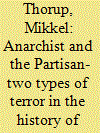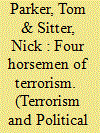| Srl | Item |
| 1 |
ID:
082922


|
|
|
|
|
| Publication |
2008.
|
| Summary/Abstract |
This article deals with the anarchist and the partisan as forerunners of contemporary terrorism. It investigates their different relationship to the state, the anarchist trying to replace it and the partisan trying to conquer it and what that means in terms of resistance, critique, and position on the use of force. The article is both theoretical and historical, trying to place the anarchist and the partisan within their different time epochs and institutional settings. It ends by discussing if and how a third type of political violence, Islamist terrorism, can be interpreted within the analytical framework of legality/illegality and regularity/irregularity worked out in the article, that is, to what extent is current the Islamist terrorist a child of the anarchist and the partisan
|
|
|
|
|
|
|
|
|
|
|
|
|
|
|
|
| 2 |
ID:
144919


|
|
|
|
|
| Summary/Abstract |
David Rapoport's concept of Four Waves of terrorism, from Anarchist terrorism in the 1880s, through Nationalist and Marxist waves in the early and mid-twentieth century, to the present Religious Wave, is one of the most influential concepts in terrorism studies. However, this article argues that thinking about different types of terrorism as strains rather than waves better reflects both the empirical reality and the idea that terrorists learn from and emulate each other. Whereas the notion of waves suggests distinct iterations of terrorist violence driven by successive broad historical trends, the concept of strains and contagion emphasizes how terrorist groups draw on both contemporary and historical lessons in the development of their tactics, strategies, and goals. The authors identify four distinct strains in total—Socialist, Nationalist, Religious, and Exclusionist—and contend that it is possible to trace each strain back to a “patient zero” active in the 1850s.
|
|
|
|
|
|
|
|
|
|
|
|
|
|
|
|